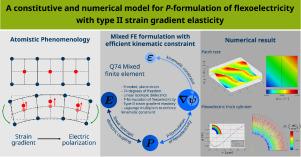A constitutive and numerical model for P-formulation of flexoelectricity with type II strain gradient elasticity
IF 3.8
3区 工程技术
Q1 MECHANICS
International Journal of Solids and Structures
Pub Date : 2025-09-27
DOI:10.1016/j.ijsolstr.2025.113668
引用次数: 0
Abstract
As the size of sensors, actuators, and electronic components is driven to the micro- and nanoscale ranges, flexoelectricity, a higher order electromechanical coupling effect, becomes more prominent. Conventional finite element framework requires elements of at least -continuity to resolve strain gradient. This requirement can be circumvented by using mixed finite element method, which considers strain components as independent degrees of freedom. Most previous studies have employed the -formulation because it is relatively straightforward to implement. However, developing a -formulation is necessary, as it enables phase-field modeling of ferroelectric domain evolution (with electric polarization serving as an order parameter) that is additionally influenced by strain gradients. Current research based on type II strain gradient elasticity presents a mixed finite element formulation capable of capturing the flexoelectric coupling effect using a kinematic constraint between relaxed strain and mechanical strain. The proposed mixed finite element is verified with a patch test and a thick cylinder problem, whose results are extensively discussed.

具有II型应变梯度弹性的柔性电p -公式的本构和数值模型
随着传感器、执行器和电子元件的尺寸被驱动到微纳米尺度,柔性电这种高阶机电耦合效应变得更加突出。传统的有限元框架要求单元至少具有c1连续性以解决应变梯度问题。采用混合有限元法可以绕过这一要求,该方法将应变分量视为独立的自由度。大多数先前的研究都采用了e配方,因为它相对容易实施。然而,开发P公式是必要的,因为它可以实现受应变梯度影响的铁电畴演化的相场建模(电极化P作为阶参数)。目前基于II型应变梯度弹性的研究提出了一种混合有限元公式,利用松弛应变和机械应变之间的运动约束来捕捉柔性电耦合效应。本文通过一个局部试验和一个厚圆柱问题对所提出的混合有限元进行了验证,并对其结果进行了广泛讨论。
本文章由计算机程序翻译,如有差异,请以英文原文为准。
求助全文
约1分钟内获得全文
求助全文
来源期刊
CiteScore
6.70
自引率
8.30%
发文量
405
审稿时长
70 days
期刊介绍:
The International Journal of Solids and Structures has as its objective the publication and dissemination of original research in Mechanics of Solids and Structures as a field of Applied Science and Engineering. It fosters thus the exchange of ideas among workers in different parts of the world and also among workers who emphasize different aspects of the foundations and applications of the field.
Standing as it does at the cross-roads of Materials Science, Life Sciences, Mathematics, Physics and Engineering Design, the Mechanics of Solids and Structures is experiencing considerable growth as a result of recent technological advances. The Journal, by providing an international medium of communication, is encouraging this growth and is encompassing all aspects of the field from the more classical problems of structural analysis to mechanics of solids continually interacting with other media and including fracture, flow, wave propagation, heat transfer, thermal effects in solids, optimum design methods, model analysis, structural topology and numerical techniques. Interest extends to both inorganic and organic solids and structures.

 求助内容:
求助内容: 应助结果提醒方式:
应助结果提醒方式:


